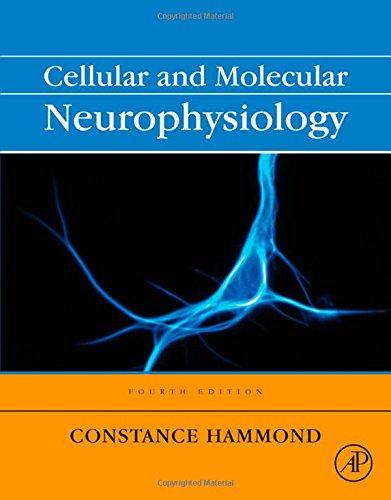Cellular and Molecular Neurophysiology Fourth Edition by Constance Hammond 0123973228 9780123973221
$50.00 Original price was: $50.00.$35.00Current price is: $35.00.
Cellular and Molecular Neurophysiology Fourth Edition by Constance Hammond – Ebook PDF Instant Download/Delivery: 0123973228, 9780123973221
Full download Cellular and Molecular Neurophysiology Fourth Edition after payment

Product details:
ISBN 10: 0123973228
ISBN 13: 9780123973221
Author: Constance Hammond
* Now in full color throughout, with over 400 carefully selected and constructed illustrations
* A concise but in-depth explanation of molecular properties and functions of excitable cells
* Includes appendices describing neurobiological techniques
* Provides a companion website presenting the figures for use in lectures
Cellular and Molecular Neurophysiology Fourth Table of contents:
Chapter 1: Neurons
Abstract
1.1. Neurons have a cell body from which emerge two types of processes: the dendrites and the axon
1.2. Neurons are highly polarized cells with a differential distribution of organelles and proteins
1.3. Axonal transport allows bidirectional communication between the cell body and the axon terminals
1.4. Neurons connected by synapses form networks or circuits
1.5. Summary: the neuron is an excitable and secretory cell presenting an extreme functional regionalization
Chapter 2: Neuron–glial cell cooperation
Abstract
2.1. Astrocytes form a vast cellular network or syncytium between neurons, blood vessels and the surface of the brain
2.2. Oligodendrocytes form the myelin sheaths of axons in the central nervous system and allow the clustering of Na+ channels at nodes of Ranvier
2.3. Microglial cells are the macrophages of the central nervous system
2.4. Schwann cells are the glial cells of the peripheral nervous system; they form the myelin sheath of axons or encapsulate neurons
Chapter 3: Ionic gradients, membrane potential and ionic currents
Abstract
3.1. There is an unequal distribution of ions across THE neuronal plasma membrane. The notion of concentration gradient
3.2. There is a difference of potential between the two faces of the membrane, called membrane potential (Vm)
3.3. Concentration gradients and membrane potential determine the direction of the passive movements of ions through ionic channels: the electrochemical gradient
3.4. The passive diffusion of ions through an open channel creates a current
3.5. A particular membrane potential, the resting membrane potential Vrest
3.6. A simple equivalent electrical circuit for the membrane at rest
3.7. How to experimentally change Vrest
3.8. Summary
Appendix 3.1. The active transport of ions by pumps and transporters maintain the unequal distribution of ions
Appendix 3.2. The passive diffusion of ions through an open channel
Appendix 3.3. The Nernst equation
Chapter 4: The voltage-gated channels of Na+ action potentials
Abstract
4.1. Properties of action potentials
4.2. The depolarization phase of Na+-dependent action potentials results from the transient entry of Na+ ions through voltage-gated Na+ channels
4.3. The repolarization phase of the sodium-dependent action potential results from Na+ channel inactivation and partly from K+ channel activation
4.4. Sodium-dependent action potentials are initiated at the axon initial segment in response to a membrane depolarization and then actively propagate along the axon
Chapter 5: The voltage-gated channels of Ca2+ action potentials: Generalization
Abstract
5.1. Properties of Ca2+-dependent action potentials
5.2. The transient entry of Ca2+ ions through voltage-gated Ca2+ channels is responsible for the depolarizing phase or the plateau phase of Ca2+-dependent action potentials
5.3. The repolarization phase of Ca2+-dependent action potentials results from the activation of K+ currents IK and IKCa
5.4. Calcium-dependent action potentials are initiated in axon terminals and in dendrites
5.5. A note on voltage-gated channels and action potentials
Chapter 6: The chemical synapses
Abstract
6.1. The synaptic complex’s three components: presynaptic element, synaptic cleft and postsynaptic element
6.2. The interneuronal synapses
6.3. The neuromuscular junction is the group of synaptic contacts between the terminal arborization of a motor axon and a striated muscle fiber
6.4. The synapse between the vegetative postganglionic neuron and the smooth muscle cell
6.5. Example of a neuroglandular synapse
6.6. Summary
Chapter 7: Neurotransmitter release
Abstract
7.1. Observations and questions
7.2. Presynaptic processes I: from presynaptic spike to [Ca2+]i increase
7.3. Presynaptic processes II: from [Ca2+] increase to synaptic vesicle fusion
7.4. Processes in the synaptic cleft: from transmitter release in the cleft to transmitter clearance from the cleft
7.5. Summary (Figures 7.16 and 7.17)
II: Ionotropic and metabotropic receptors in synaptic transmission
Chapter 8: The ionotropic nicotinic acetylcholine receptors
Abstract
8.1. Observations
8.2. The torpedo or muscle nicotinic receptor of acetylcholine is a heterologous pentamer α2βγδ
8.3. Binding of two acetylcholine molecules favors conformational change of the protein towards the open state of the cationic channel
8.4. The nicotinic receptor desensitizes
8.5. nAChR-mediated synaptic transmission at the neuromuscular junction
8.6. Nicotinic transmission pharmacology
8.7. Summary
Chapter 9: The ionotropic GABAA receptor
Abstract
9.1. Observations and questions
9.2. GABAA receptors are hetero-oligomeric proteins with a structural heterogeneity
9.3. Binding of two GABA molecules leads to a conformational change of the GABAA receptor into an open state; the GABAA receptor desensitizes
9.4. Pharmacology of the GABAA receptor
9.5. GABAA-mediated synaptic transmission
9.6. Summary
Chapter 10: The ionotropic glutamate receptors
Abstract
10.1. There are three different types of ionotropic glutamate receptors. They have a common structure and all participate in fast glutamatergic synaptic transmission
10.2. AMPA receptors are an ensemble of cationic receptor-channels with different permeabilities to Ca2+ ions
10.3. Kainate receptors are an ensemble of cationic receptor channels with different permeabilities to Ca2+ ions
10.4. NMDA receptors are cationic-receptor-channels highly permeable to Ca2+ ions; they are blocked by Mg2+ ions at voltages close to the resting potential, which confers strong voltage dependence
10.5. Synaptic responses to glutamate are mediated by NMDA and non-NMDA receptors
10.6. Summary
Chapter 11: The metabotropic GABAB receptors
Abstract
11.1. GABAB receptors were originally discovered because of their insensitivity to bicuculline and their sensitivity to baclofen
11.2. Structure of the GABAB receptor
11.3. Summary
11.4. GABAB receptors are G-protein coupled to a variety of different effector mechanisms
11.5. Summary
11.6. The functional role of GABAB receptors in synaptic activity
11.7. Summary
Chapter 12: The metabotropic glutamate receptors
Abstract
12.1. The identification of the eight metabotropic glutamate receptor subtypes
12.2. How do metabotropic glutamate receptors carry out their function? Structure–function studies of metabotropic glutamate receptors
12.3. How to identify selective compounds acting at the metabotropic glutamate receptor – towards the development of new therapeutic drugs
12.4. What biochemical means do metabotropic glutamate receptors utilize to elicit physiological changes in the nervous system? Signal transduction studies of metabotropic glutamate receptors
12.5. How is the activity of metabotropic glutamate receptors modulated? Studies of mGluR desensitization
12.6. Metabotropic glutamate receptors modulate neuronal excitability
12.7. Metabotropic glutamate receptors mediate and modulate synaptic transmission
12.8. Pre- and postsynaptic functional assembly of metabotropic glutamate receptors
12.9. Physiological roles of metabotropic glutamate receptor – a study of knockout models
12.10. Summary
III: Somato-dendritic processing and plasticity of postsynaptic potentials
Chapter 13: Somato-dendritic processing of postsynaptic potentials I: Passive properties of dendrites
Abstract
13.1. Propagation of excitatory and inhibitory postsynaptic potentials through the dendritic arborization
13.2. Summation of excitatory and inhibitory postsynaptic potentials
13.3. Summary
Chapter 14: Subliminal voltage-gated currents of the somato-dendritic membrane
Abstract
14.1. Observations and questions
14.2. The subliminal voltage-gated currents that depolarize the membrane
14.3. The subliminal voltage-gated currents that hyperpolarize the membrane
14.4. Conclusions
Chapter 15: Somato-dendritic processing of postsynaptic potentials II. Role of sub-threshold depolarizing voltage-gated currents
Abstract
15.1. Persistent Na+ channels are present in the axo-somatic region of neocortical neurons; INaP boosts EPSPs
15.2. T-type Ca2+ channels are present in the dendrites of cortical neurons; ICaT boosts EPSPs
15.3. The hyperpolarization-activated cationic current Ih is present in dendrites of hippocampal pyramidal neurons; Ih attenuates EPSPs
15.4. A-type K+ channels are present in the dendrites of hippocampal neurons; IA attenuates EPSPs
15.5. Functional consequences
15.6. Conclusions
Chapter 16: Somato-dendritic processing of postsynaptic potentials III. Role of high-voltage-activated depolarizing currents
Abstract
16.1. High-voltage-activated Na+ and/or Ca2+ channels are present in the dendritic membrane of some CNS neurons, but are they distributed with comparable densities in soma and dendrites?
16.2. High-voltage-activated Ca2+ channels are present in the dendritic membrane of some CNS neurons, but are they distributed with comparable densities in soma and dendrites?
16.3. Functional consequences
16.4. Conclusions
Chapter 17: Firing patterns of neurons
Abstract
17.1. Medium spiny projection neurons of the striatum
17.2. Inferior olivary cells
17.3. Purkinje cells are pacemaker neurons that respond by a complex spike followed by a period of silence
17.4. Thalamic and subthalamic neurons
Chapter 18: Synaptic plasticity
Abstract
18.1. Short-term potentiation (STP) of a cholinergic synaptic response as an example of short-term plasticity: the cholinergic response of muscle cells to motoneuron stimulation
18.2. Long-term potentiation (LTP) of a glutamatergic synaptic response: example of the glutamatergic synaptic response of pyramidal neurons of the CA1 region of the hippocampus to Schaffer collateral activation
18.3. The long-term depression (LTD) of a glutamatergic response: example of the response of Purkinje cells of the cerebellum to parallel fiber stimulation
18.4. Long-term synaptic modification induced by relative timing between pre- and postsynaptic activity: spike-timing-dependent plasticity (STDP)
18.5. The homeostatic plasticity of a glutamatergic response: example of the synaptic scaling at neocortical gluTaMatergic synapses
IV: The hippocampal network
Chapter 19: The adult hippocampal network
Abstract
19.1. Observations and questions
19.2. The hippocampal circuitry
19.3. Activation of interneurons evokes inhibitory GABAergic responses in postsynaptic pyramidal cells
19.4. Activation of principal cells evokes excitatory glutamatergic responses in postsynaptic interneurons and other principal cells (synchronization in CA3)
19.5. Oscillations in the hippocampal network: example of sharp waves (SPW)
19.6. Summary
Chapter 20: Maturation of the hippocampal network
Abstract
20.1. GABAergic neurons and GABAergic synapses develop prior to glutamatergic ones
20.2. GABAA receptor-mediated responses differ in developing and mature brains
20.3. Maturation of coherent networks activities
20.4. Conclusions
Contributors
Index
People also search for Cellular and Molecular Neurophysiology Fourth:
what is molecular and cellular neuroscience
basic neurochemistry principles of molecular cellular and medical neurobiology
cellular and molecular techniques
cellular vs molecular
Tags:
Constance Hammond,Cellular,Molecular



